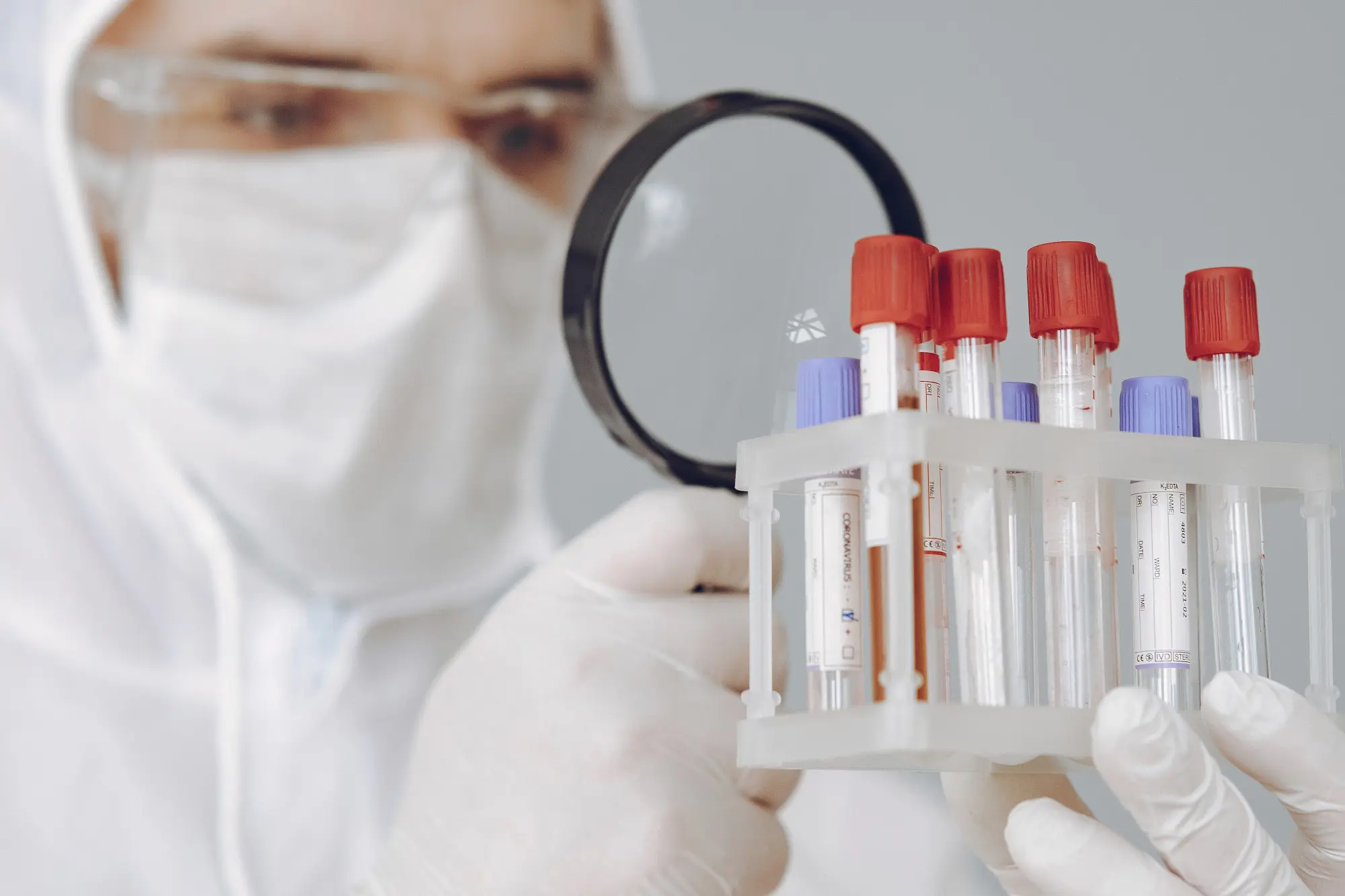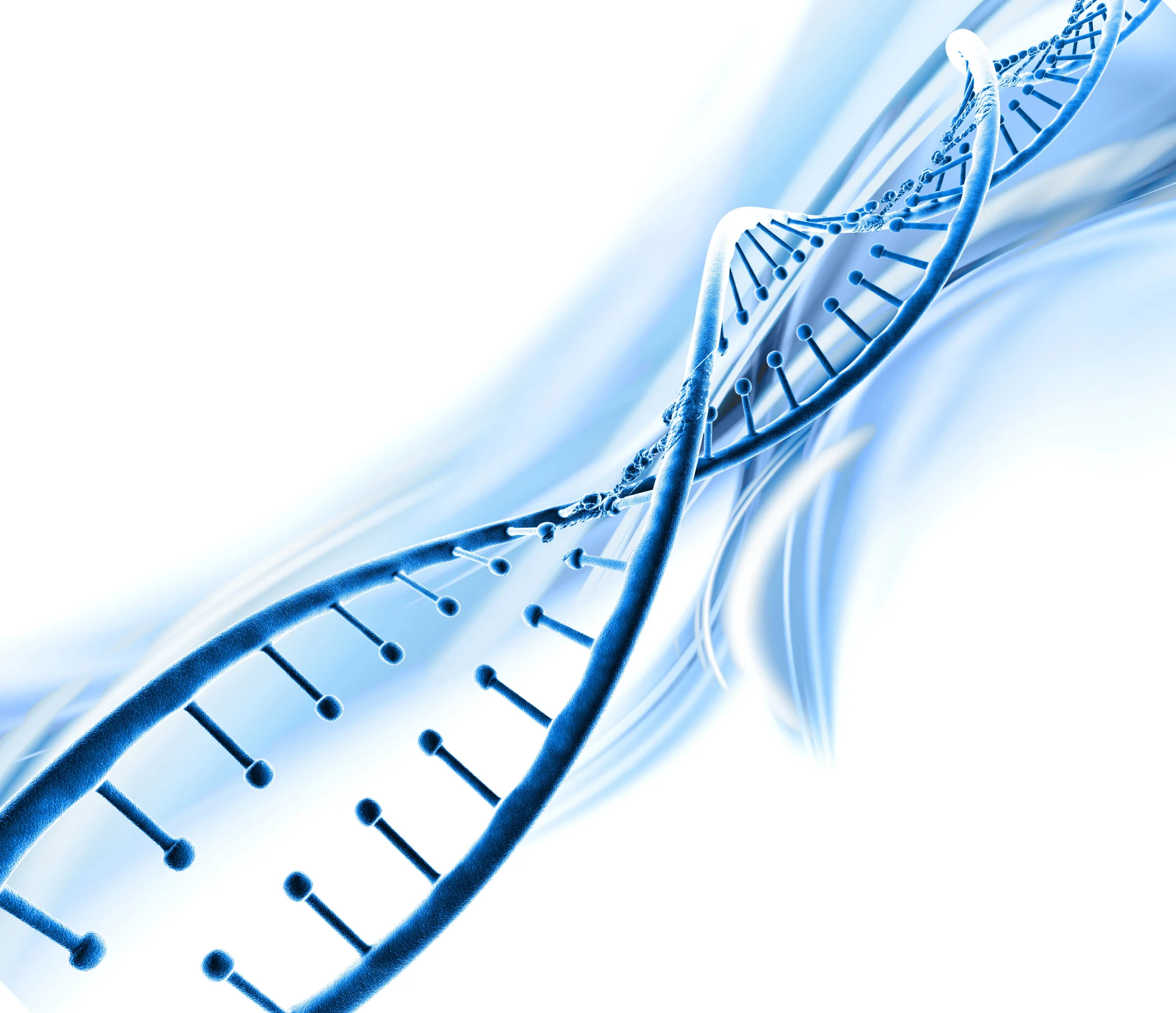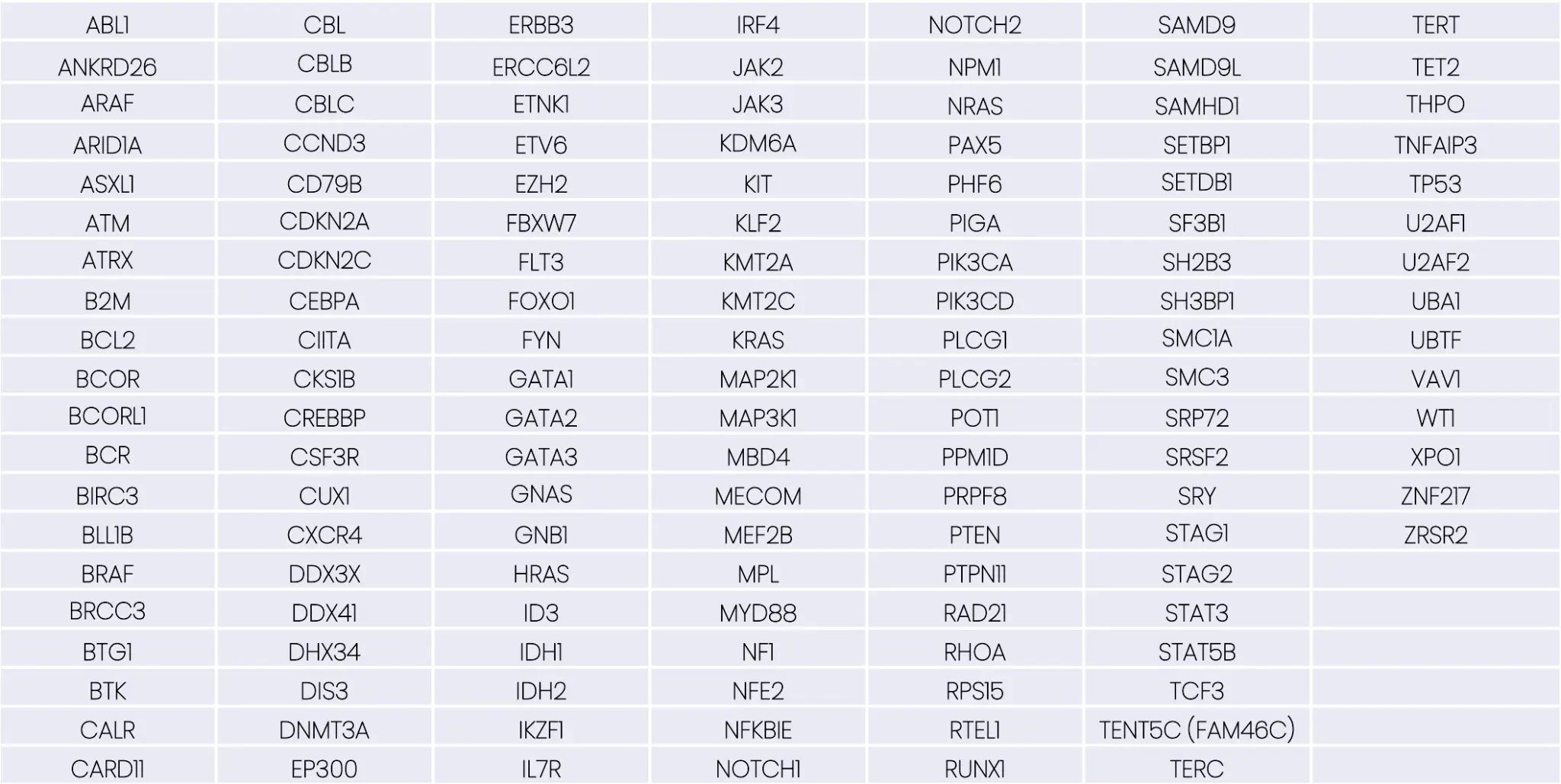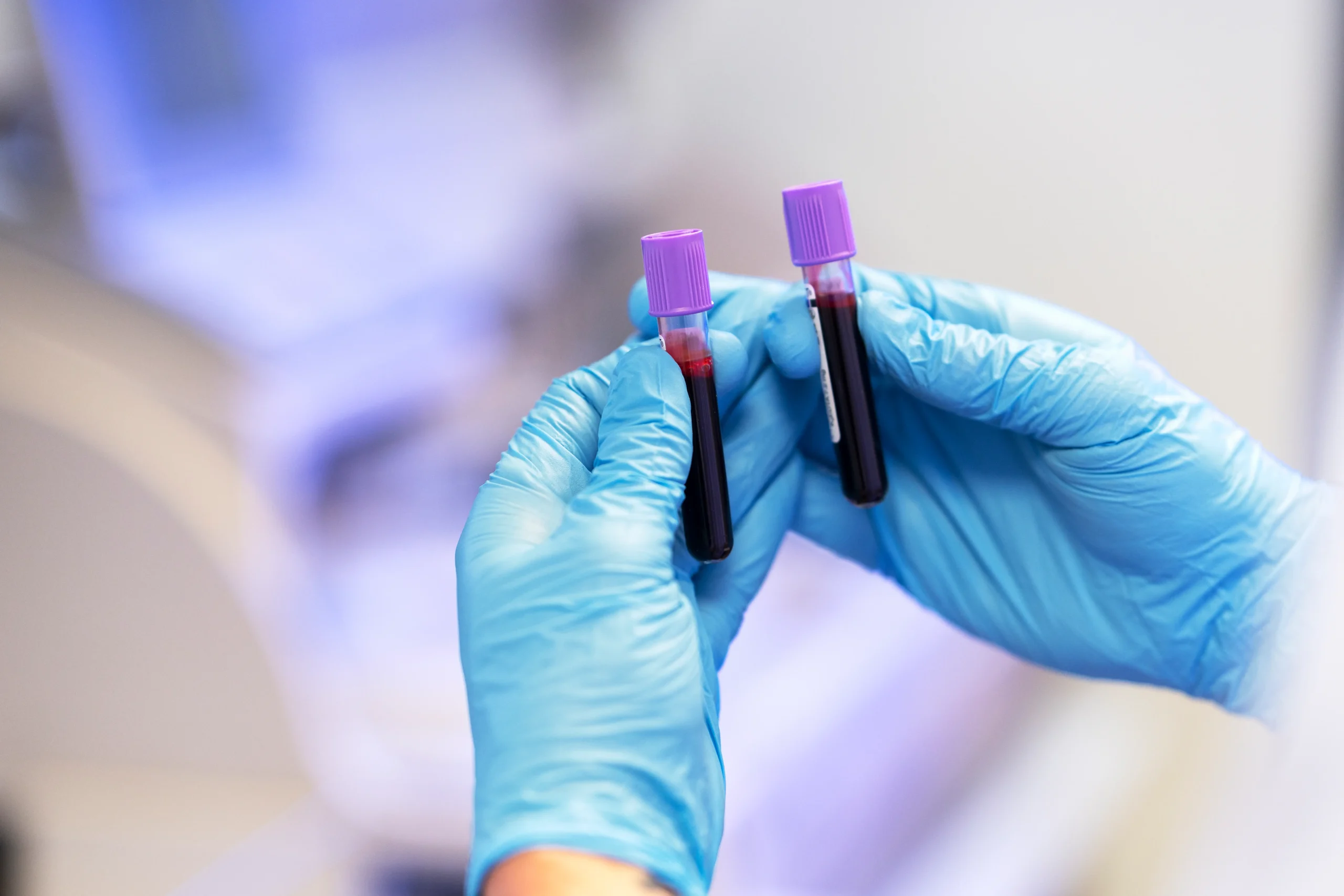
PanHemeOnc panel
Fast and streamlined NGS profiling for both lymphoid and myeloid disorders

Actionable mutation panel
Detect low frequency variants in key oncogenes of the Epidermal Growth Factor Receptor

Carrier screening panel
Accurately analyze carrier status of 448 inherited childhood disorders using a single workflow
Cell3™ Target: PanHemeOnc Panel
Streamlining genetic testing for hematological malignancies
Testing for myeloid and lymphoid malignancies needs to be fast
Successful treatment and improved prognosis of hematological cancer is directly impacted by the speed and efficacy of diagnosis.1
The complexity of hematological malignancies often means laboratories have to use an interrogative and iterative testing approach across multiple different platforms. Leveraging Cell3 Target NGS panels to detect all key variants allows laboratories to streamline their workflows into one single test advancing hemato-oncology patient care.
The Cell3 Target: PanHemeOnc panel, designed by WMRGL is available as a customer-led design for any lab also looking to streamline their lymphoid and myeloid workflows.

| Fast | Streamlined | Comprehensive | Trusted | Proven |
|---|---|---|---|---|
| Prepare NGS libraries in as little as one day | Reduce multiple testing strategies into one simple workflow. | Comprehensive design enables the detection of clinically relevant variants across multiple regions associated with both myeloid and lymphoid neoplasia | Customer led, Nonacus custom design collaboration with Joanne Mason, Head of Haemato-oncology, West Midlands Regional Genomics Laboratory | SNVs detected at Variant Allele Fractions (VAF) as low as 1%. Detection of challenging targets including FLT3-ITD |
| ✓ | ✓ | ✓ | ✓ | ✓ |

Profile all key myeloid and lymphoid mutations in one test
The panel design covers variants in 134 genes (including SRY for gender ID only) and 13 key regions for CNVs*, as well as boosted FLT3 coverage, KMT2A including exons and introns 1-14, and whole gene deletion events.
* CNV coverage: CNV del(1p), CNV gain(1q), CNV (11q), CNV 13q14; del(17p), CNV del(17p), CN-LOH 6p, CEBPA, GATA2, RUNX1, TERC, TERT, trisomy12
Complete coverage of key genes
All transcripts covered for all genes

Cell3™ Target: Actionable Mutation panel (EGFR)
Detect low frequency variants in key oncogenes of the Epidermal Growth Factor Receptor (EGFR) pathway using genomic DNA (gDNA) or cell-free DNA (cfDNA) from primary tumors or liquid biopsies.
Clinically relevant content
A highly focused panel covering the actionable mutations in key oncogenes in the EGFR pathway.
Primary tumor or liquid biopsy
Developed for and validated on cfDNA as well as gDNA and FFPE giving you the option to profile primary tumors or liquid biopsies and matched samples.
Confidently call low frequency variants
Cell3 Target error suppression technology including unique molecular identifiers (UMIs), enables you to accurately call ultra-low frequency mutations down to 0.1% VAF.
Fast and affordable
Using a focused panel simplifies analysis and reduces costs making this a fast and affordable method of profiling variants in the EGFR pathway.
Focused coverage of EGFR pathway
We know that a fast and affordable panel for profiling pathways like the EGFR (Epidermal Growth Factor Receptor) pathway is important to you so the Cell3 Target: Actionable Mutation panel (EGFR) only enriches for actionable mutations in the most relevant oncogenes. It offers a simple, fast and cost-effective tool to enable early cancer detection, treatment selection and patient monitoring in cancers like non-small lung cancer.
Sensitive enough for liquid biopsy
Liquid biopsy offers a non-invasive method of detecting cancer early or monitoring cancer post chemotherapy or surgery, but it requires extremely sensitive analysis due to the small amounts of cell-free DNA (cfDNA) and even smaller amounts of circulating tumor DNA (ctDNA) present.
The error suppression technology of Nonacus Cell3 Target libraries includes unique molecular indexes (UMIs) and unique dual indexes (UDIs) for removal of both PCR and sequencing errors and index hopping events. This ensures that the Actionable Mutation panel (EGFR) will enable you to confidently call mutations down to 0.1% VAF and enables generation of sequencing libraries from as little as 1 ng of cfDNA input.

| Product | Sequencer | Flow cell | Samples/flow cell | Average depth (expected) |
|---|---|---|---|---|
| Actionable Mutation Panel | MiSeq Micro v2 | 300 cycle | 19 | 500x gDNA/FFPE/FF |
| Actionable Mutation Panel | MiSeq v2 | 500 cycle | 72 | 500x gDNA/FFPE/FF |
| Actionable Mutation Panel | MiSeq v3 | 300 cycle | 120 | 500x gDNA/FFPE/FF |
| Actionable Mutation Panel | MiSeq v2 | 500 cycle | 2 | 20,000x Liquid biopsy ctDNA |
| Actionable Mutation Panel | MiSeq v3 | 300 cycle | 3 | 20,000x Liquid biopsy ctDNA |
| Actionable Mutation Panel | NextSeq | 300 cycle mid output | 19 | 20,000x Liquid biopsy ctDNA |
| Actionable Mutation Panel | NextSeq | 300 cycle high output | 64 | 20,000x Liquid biopsy ctDNA |
| Actionable Mutation Panel | NovaSeq SP | 300 cycle | 120 | 20,000x Liquid biopsy ctDNA |
Cell3™ Target: Carrier Screening panel
Accurately analyze carrier status of 448 inherited childhood disorders using a single workflow.
Comprehensive content
Designed to enrich for genes with high clinical significance in a broad range of rare, highly penetrant recessive childhood disorders.
Streamlined workflow
Consolidate multiple technology workflows into one simple NGS assay. No arrays. No Multiplex Ligation-dependent Probe Assay (MLPA).
Saves time and resources
One workflow saves you time and sample, without compromising on quality or robustness.
Cost-effective
Optimized so that as little 2.7 Gb of data per sample is required to achieve accurate carrier status.
Expanded carrier screening
Traditionally, molecular research laboratories have based their analysis of carrier status on just a few genetic changes based on family history and/or ethnicity. However, with the advances in next generation sequencing (NGS) and identification of more causative variants—both sequence and structural— it is becoming not just possible, but important, to expand carrier screening to include more variants and diseases.
That’s why Nonacus have developed Cell3 Target library preparation solutions for NGS. Combining the analysis of SNVs, INDELs and CNVs into a single assay, saves you time and resources and still delivers a comprehensive report on a broad range of penetrant recessive childhood disorders, all from one workflow.
Comprehensive coverage of clinically relevant genes
We know that coverage of the most clinically relevant genes is important to you. The 448 disorders represented on the Nonacus Cell3 Target: Carrier Screening panel all meet the American College of Medical Genetics (ACMG) guidelines and have been selected based on their high penetrance and clinical significance.1
For each gene selected, all coding exons and splice site junctions and intronic, regulatory and untranslated regions known to contain disease mutations have been targeted.
See Product Resources below to see the full list of disorders included on the panel.
| Type of Disorder | Number of Genes Covered |
|---|---|
| Cardiac | 8 |
| Cutaneous | 45 |
| Deafness | 2 |
| Developmental | 46 |
| Endocrine | 15 |
| Gastroenterologic | 3 |
| Hematologic | 19 |
| Hepatic | 3 |
| Immunodeficiency | 29 |
| Metabolic | 142 |
| Neurodegenerative | 1 |
| Neurological | 119 |
| Neuromuscular | 2 |
| Ocular | 12 |
| Renal | 25 |
| Respiratory | 8 |
| Skeletal | 28 |
| Grand Total | 507 |
In depth carrier status report from one test
For expanded carrier screening to be effective we know you need to be able to assess a range of genetic variants including copy number deletions or duplications.
We also know that this can mean running a host of workflows from PCR and MLPA to sequencing and microarrays. This not only increases the time it can take you to reach a final report but can have a significant impact on your cost per test.
The Cell3 Target: Carrier Screening panel streamlines this allowing you to carry out targeted sequencing and copy number analysis and deliver a comprehensive carrier status report from a single test.

Maximize sequencing efficiency
By increasing the yield per sample, Nonacus Cell3 Target library prep solutions allow you to run more samples per flow cell increasing your efficiency and reducing your cost per sample.
| Sequencer | Flow Cell | Samples/Flow Cell | Average Depth (Expected) |
|---|---|---|---|
| NextSeq | 300 cycle mid output | 48 | 160x |
| NextSeq | 300 cycle high output | 144 | 160x |
| NovaSeq SP | 300 cycle | 288 | 160x |
| NovaSeq S1 | 200 cycle | n/a | 160x |
| NovaSeq S2 | 200 cycle | n/a | 160x |
| NovaSeq S4 | 200 cycle | n/a | 160x |

Nonacus has an extensive publication portfolio that supports our innovative solutions in genetic and genomic analysis. We are proud to share our contributions and latest research findings with the scientific community. Our publications range from non-invasive prenatal testing (NIPT) to cancer genomic analysis and make significant contributions to scientific progress. Below, you can explore our latest research and studies.

